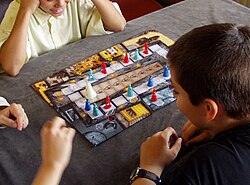Midnight party
| Midnight Party Hugo - the castle ghost |
|
|---|---|
 Hugo is still on the cellar stairs |
|
| Game data | |
| author | Wolfgang Kramer |
| graphic | Franz Vohwinkel (2013) |
| publishing company |
Ravensburger (1989, 1996), Amigo (2013) |
| Publishing year | 1989, 1996, 2013 |
| Art | Board game |
| Teammates | 2 to 8 |
| Duration | 20-30 minutes |
| Age | from 8 years
|
| Awards | |
|
Game of the year 1989: shortlist |
|
Midnight Party is a board game for children by Wolfgang Kramer from 1989. It was first published by Ravensburger . In 1996 it was reissued under the original name as Hugo - the castle ghost also at Ravensburger and finally in 2013 at AMIGO Spiel + Freizeit GmbH .
material

- 30 pawns in 8 colors (depending on the number of players each receives 2-6 pawns)
- Ghost figure
- Ghost cubes with numbers 1, 2, 4 and 5 and two ghost representations
- game schedule
procedure
A party is taking place at a castle that also houses a ghost named "Hugo". Each player moves his pawns on the gallery of the castle by throwing the dice clockwise. If the die shows a ghost, Hugo goes into action. From his starting space in the basement of the castle, he moves three spaces up the stairs to the guests' gallery every time he rolls a ghost. As soon as he encounters or overtakes a guest along the gallery, he scares him. The pawn is taken from the gallery and placed on the lowest free space on the cellar stairs. If this is already occupied, more prisoners come into the wine cellar. This also happens if there are no more rooms available (the corresponding figures are immediately placed there and the round is over). The wine cellar brings 2 minus points.
In order to bring his own playing figures to safety, the players have the option of dragging their figures into rooms in the gallery, into which Hugo does not enter. To do this, the room does not have to be reached with the exact number of points on the die, with the exception of the two rooms, in which the player receives 3 plus points at the end of a round. Furthermore, each room only allows one guest to hide. In two special rooms, however, you get a minus point at the end of a round. If a player has brought all of his pieces to safety or lost them to Hugo, he still rolls the dice. Although he cannot move any more pieces when he has a number, if he rolls a ghost, it continues to move.
The game ends as soon as all party goers have either hidden in rooms or scared onto the basement stairs . It is then evaluated: on the steps of the basement stairs, negative values that descend downwards are recorded. Some rooms are also marked with plus or minus points. The winner is whoever achieved the fewest negative points after three rounds of the game.
Translations, prizes and awards
In 1989 Kramer's game was on the selection list for Game of the Year . It was broadcast into English, as a Ghost Party and as a Midnight Party , as well as in other languages.
Radio plays
From 1989 onwards, Ravensburger published eight radio plays on the Karussell label called Midnight Party with Hugo the Castle Ghost with the voice of Michael Harck in the title role. Hans Paetsch gave the narrator . In addition, Wika Krauts could be heard as the old Countess and Peter von Schultz as her butler James.
In 2019, the audio play label Die Hörkastanie started a new series of Hugo's Midnight Party , which is based on the old radio plays, but takes place 30 years later. Besides Sven Plate as Hugo, Matthias Keller as James' successor Ralph and Dagmar Bittner as young Countess Anastasiya von Gruselstein u. a. Hans-Georg Panczak can be heard as game designer Wolfgang Kramer.
Web links
- Midnight Party (1989) in the Luding games database
- Midnight party in the game database BoardGameGeek (English)